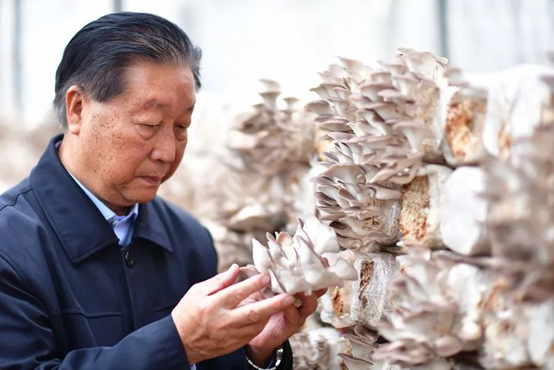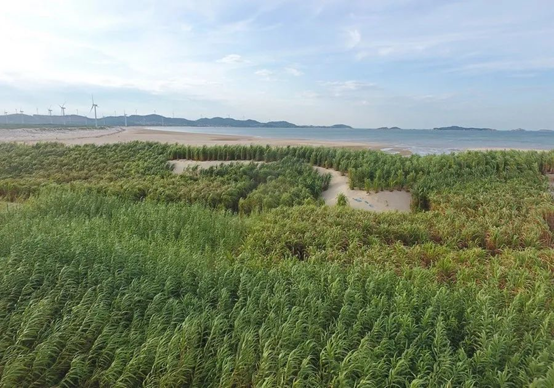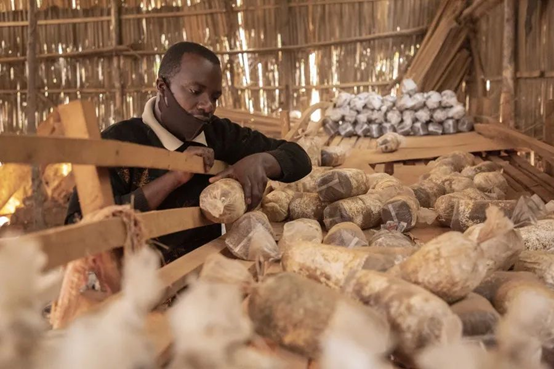新华社北京11月16日电 拉万迪.易普拉欣.达蒂先生(Mr.Lawandi Ibrahim Datti)自豪地向他的同事们介绍了尼日利亚建立的菌草技术应用示范中心。达蒂在位于中国东部福建省的福建农林大学攻读菌草科技博士学位,他发现菌草技术有望改变自己家乡的土地退化与贫穷的恶性循环的困境。
菌草技术,也被称为“中国神草”,意思是利用菌草来栽培菌菇、饲养牲畜、生态治理、生物质能源和生物质材料开发利用的一项综合技术。中国科学家发明的这种特殊的菌草已经成功替代传统原材料木材,栽培菌菇,既经济、又环保。
“菌草技术帮助我的国家在保障食品安全、提供更多的动物饲料和消除贫困方面发挥了良好作用,”达蒂说。这是习近平主席倡导的用于援助友好的发展中国家的优良项目。
习主席的支持
上世纪80年代中期,习近平作为福建省的一名官员,他为农村发展和扶贫殚精竭虑。
当时,蓬勃发展的菌菇生产在福建农村地区事关千家万户的生计。然而,菌菇种植的成功正威胁着这个行业自身的未来。当地农民为种菇而砍伐树木作为栽培菌菇基质原材料导致了大规模森林砍伐,这使得可利用的木材越来越缺乏,反过来又损害了广大菇农的正常生产和经济利益。
习近平发现“野草栽培食用菌”技术的研究具有解决这一难题的潜力。这一研究由福建农业科学家林占熺主持开展,他正是“菌草”技术的发明者。34年前,他成功选择了一些不同品种的草来代替木材作为菌菇生长的基质原材料。这不但使得广大菇农的生产可以持续,还拯救了大片的天然森林。虽然林占熺教授的研究已经取得了初步的成果,但他一直缺乏资金建造一个专门的菌草实验室以进一步发展技术。抱着最后一丝希望,这位科学家在2001年写了一封信,表示迫切需要当地政府的支持。他的请求得到了时任福建省省长习近平的亲自关注和扶持。
“因为有了习主席的支持,我们建立了在福建省乃至中国和世界的第一个菌草科学实验室”林教授说,“我们从而能够继续进行研究工作”。
经过几十年来的不间断地试验、创新和发展,林占熺教授已经成功筛选出45种菌草,可用于栽培55种菌菇。林和他的团队还将菌草用作家畜家禽的饲料,用于荒漠化和沙漠化治理以及新的生物质材料的开发。

图为:福建农林大学林占熺研究员在检查平菇生长情况
推动菌草技术在全国范围的应用
习主席认可菌草技术并于1997年将其列为东西部协作项目,由福建省选派技术专家组赴宁夏回族自治区帮助解决贫困问题。
宁夏西海固是中国西北闻名的贫瘠贫困的地区,当地首批27户加入“菌草技术”项目的农民收入迅速翻番。10年后,该地区共有17500多户投入菌草技术种菇的农民,每户每年增加700多美元(约合5000元人民币)的收入。
习主席的举措为食用菌产业在宁夏提供新的契机。宁夏自治区彭阳县“闽宁农业科技示范园”负责人齐登荣说,“菌草产业的兴起带动了当地的农业循环经济发展”。
在过去20多年间,菌草技术通过应用于新疆维吾尔自治区、西藏自治区和宁夏回族自治区等省区的扶贫项目,在国内大范围地广泛推广。到目前为止,全国已有500多个县参与菌草技术产业。不仅极大地降低了生产成本,每年还在全国范围内减少了2000万立方米的树木砍伐量。
就像它使数百万农民的生活重振活力一样,这种草还改造了曾经荒凉的土地。在黄河上游的乌兰布和沙漠中开展的一项试验表明,顽强的菌草能够在干旱的沙漠中生存,并将沙丘变成绿洲。
中国科学家设想了一个更大的计划,到2021年在中国第二大河黄河沿线建起千里菌草绿色屏障,治理严重的土壤侵蚀,保护生态和防治荒漠化。

图为:福建省平潭县海滩的一处菌草防风种植带
在全世界播下希望的种子
“我去了福建省”,巴布亚新几内亚东高地省前省长佩迪.拉法纳马先生说,“我会见了时任福建省省长的习近平主席,我认为他的心中时刻牵挂着广大人民”。拉法纳玛先生指的是2000年他访华到福建省和习近平的会见,习近平当时签署了合作协议启动在巴新开展菌草技术试点项目,以帮助该国扶贫并改善当地人民的生活状况。
2018年11月,习近平以国家主席身份访问该国时,中国菌草技术预计将在未来5年内帮助3万户当地居民脱贫。在当时他访问巴新并出席亚太经合组织(APEC)领导人会议期间,两国又签署了菌草技术援助的新项目。
在习主席此访的前一年,菌草在巴布亚新几内亚的产量已达到每公顷854吨的世界纪录。每公顷的收获量可饲养400-500只羊,或者用于种植100吨鲜菌菇。
作为一种低成本、经济适用和易学易用的促进农村产业发展项目,菌草技术目前已通过中国政府组织的技术培训援助和现场示范等方式传播到了全球106个国家。
2019年在联合国总部举行的联合国菌草技术项目高级别会议上,时任联合国大会主席的玛利亚.埃斯皮诺萨.格雷斯女士赞叹说,“菌草技术赋予了这种草本植物在消除贫困、发展清洁能源、保障性别平等和助力生物多样性保护等方面的很多可利用优势”。
玛利亚.埃斯皮诺萨.格雷斯主席表示,“菌草技术”是中国“一带一路”倡议的象征,它助力于实现联合国《2030年可持续发展议程》。

图为:旺达首都基加利一家使用菌草技术种植菌菇的公司老板在检查菌丝生长情况
(转载自:援斐济菌草技术示范中心微信公众号)
Xi's vision of magic grass inspires global poverty relief
BEIJING, Nov. 16 (Xinhua) -- Lawandi Ibrahim Datti betrayed a sense of pride as he introduced the Juncao demonstration center established in his home country Nigeria to his colleagues. As a PhD student studying Juncao technology in east China's Fujian Province for more than a decade, Datti saw an opportunity to change his country's rural landscape caught in a vicious cycle of land degradation and poverty.
Juncao, which is famed as magic grass, is two Chinese characters meaning mushroom and grass. The particular breed of grass was discovered by Chinese scientists to be an economical and environment-friendly substitute for timber to be used as substrate for growing mushrooms.
Juncao technology helps my country with food security, animal feed and poverty eradication, Datti said. It is a good initiative by President Xi Jinping.
SUPPORT FROM XI
In the mid-1980s, when Xi Jinping started working in Fujian as a local government official, he spent considerable energy for rural development and poverty alleviation in the province.
The booming mushroom business was then lucrative in Fujian's rural areas. The success of mushroom farming, however, was threatening the future of the industry itself. The felling of trees on a large scale by local farmers for fungi substrate led to deforestation, which in turn dented economic benefits.
A potential solution, Xi discovered, could be found in research being conducted in Fujian on a group of wild grasses.
The research was led by Lin Zhanxi, an agricultural scientist in Fujian and none other than the inventor of Juncao technology. Thirty-four years ago, Lin selected the grass species to replace timber as a substrate for growing mushrooms and this saved vast tracts of natural forest.

Lin Zhanxi from Fujian Agriculture and Forestry University checks mushrooms cultivated on chopped Juncao in Fuzhou, southeast China's Fujian Province, Nov. 2, 2018. (Xinhua/Wei Peiquan)
While Lin's study had yielded preliminary results, he was frustrated by the lack of funding for a designated Juncao laboratory to further technological advancement.
Holding on to the last shred of hope, the scientist penned a letter in 2001 to express the urgent need for the local government's endorsement. His plea was met with the attention and support of Xi Jinping, then governor of Fujian Province.
Because of Xi's assistance, we would build the Juncao science laboratory, the first of its kind in Fujian Province, the country and the world, Lin said. Only then could we proceed with our work.
After decades of continuous experiments, Lin has developed 45 varieties of Juncao, which can be used to cultivate 55 mushroom species. Lin and his team have also been able to use the grass as livestock forage, as well as for environmental rehabilitation and development of new materials.
PUSH FOR NATIONWIDE APPLICATION
Endorsed by Xi, Juncao technology was included in 1997 in a regional-pairing initiative to help tackle poverty in Ningxia Hui Autonomous Region.
In Xihaigu of Ningxia, then a barren and poverty-stricken land in northwest China, the first 27 farmers to join the Juncao program quickly doubled their incomes. Ten years later, there were 17,500 Juncao farmers across the region, each adding more than 700 U.S. dollars to their annual income.
Xi's initiative offered fresh opportunities for the edible mushroom industry in Ningxia, said Qi Dengrong, head of Fujian-Ningxia Agricultural Science and Technology Demonstration Park in Ningxia's county of Pengyang. And the rise of Juncao industry has put in motion the local agricultural circular economy.

Aerial photo taken on July 25, 2020 shows a view of a Juncao field in Pingtan County, southeast China's Fujian Province. (Xinhua/Lin Shanchuan)
Over the past two decades, the agricultural technology has been widely promoted at home through China's poverty alleviation projects in areas including Xinjiang Uygur, Tibet and Ningxia Hui autonomous regions.
So far, more than 500 counties across China have participated in planting Juncao. The grass significantly lowered farming costs, and reduced annual tree clearing by 20 million cubic meters in the country.
Much like the way it revived millions of farmers' lives, the grass transformed once bleak landscapes. In Ulan Buh Desert, which has been encroaching the upper reaches of the Yellow River, a pilot experiment showed that the tenacious grass could survive in the arid terrain and turned the sand dunes into oasis.
Chinese scientists have envisioned a greater plan for a 1,000-km-long green barrier of Juncao along the country's second-longest river by 2021 to treat the heavily eroded land and protect it from invasion by sand.
PLANTING SEEDS OF HOPE WORLDWIDE
I did go to Fujian Province. I met my then colleague Governor Xi Jinping, said Peti Lafanama, former governor of Papua New Guinea's Eastern Highlands Province. I think the President has a heart for the people.
The meeting Lafanama referred to took place in 2000, where Xi helped launch a pilot Juncao project to improve the lives of locals in the impoverished country.
In November 2018, when Xi visited this country as Chinese president, the grass was expected to lift 30,000 local people out of poverty in the next five years. During his visit, the two countries signed another aid project using the grass technology, a day ahead of the Asia-Pacific Economic Cooperation (APEC) Leaders' Meeting scheduled in Papua New Guinea.
Just one year before Xi's visit, the yield of the grass in Papua New Guinea set a world record of 854 tonnes per hectare. The harvest per hectare can feed 400-500 sheep or help grow 100 tonnes of fresh mushrooms.

Emmanuel Ahimana, owner of a Rwandan company which applies Juncao technology to grow mushrooms, works at his workshop in Kigali, Rwanda, Sept. 9, 2020. (Photo by Cyril Ndegeya/Xinhua)
As an affordable and accessible way to stimulate the agricultural industry, Juncao technology has now been disseminated to 106 countries through training programs or on-site demonstrations.
In a meeting on Juncao technology held at the UN headquarters in 2019, then UN General Assembly President Maria Fernanda Espinosa Garces said that the herbaceous plant contributes to poverty eradication, clean energy, gender equality and biodiversity preservation.
The Juncao technology is emblematic of the China's Belt and Road Initiative, Espinosa said. It supports the 2030 Agenda for Sustainable Development.
(Video reporters: Ni Hanlin, Zhang Boning, Chen Wang, Lu Ying, Wang Hongyu, Zhang Cheng, Wang Xuebing)
(转载自:新华网)